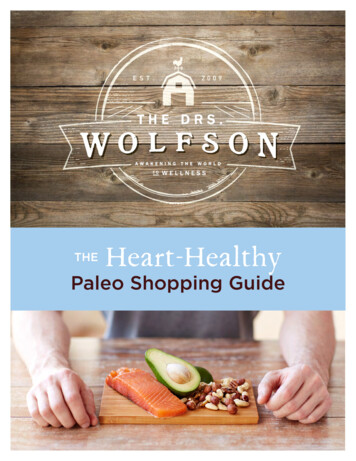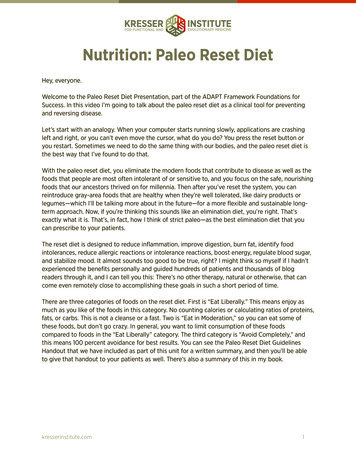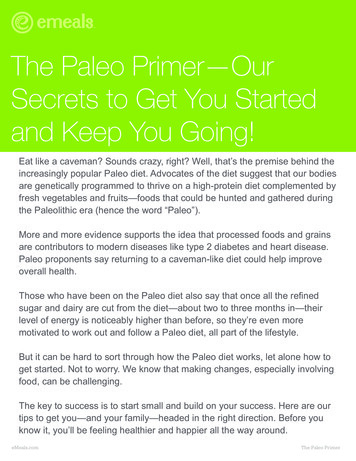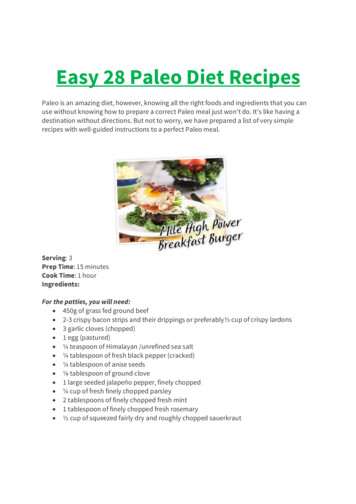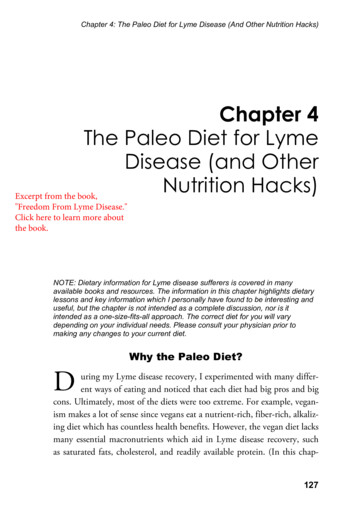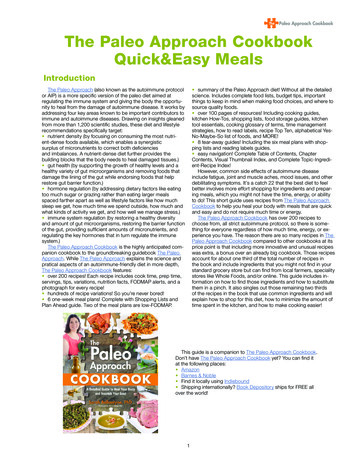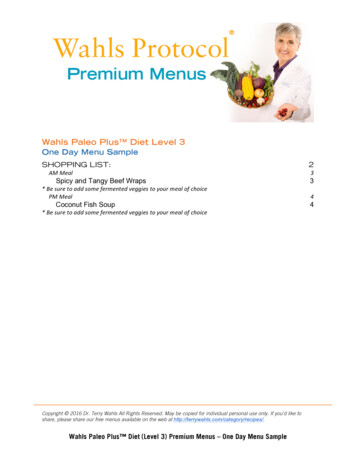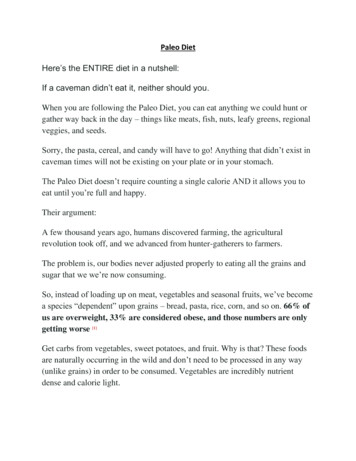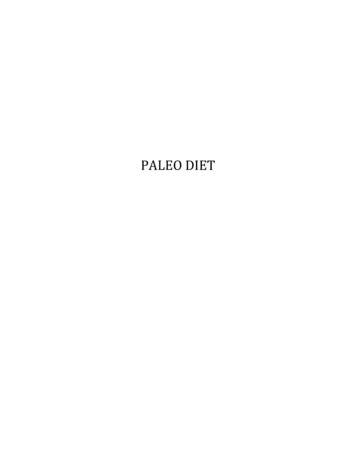
Transcription
PALEO DIET
TABLE of CONTENTSIntroduction/Background of Fad Diet Promised Outcomes Nutritional Breakdown .“Good” and “Bad” Foods Supplements Cost of Plan .Time Commitment “Special” Foods/Items .Exercise Component .Creator .Consumer Reviews Professional Reviews Your Evaluation of the Diet .Your Recommendation .References/Works Cited .
Introduction/Background of Fad DietThe Paleolithic diet is actually called the Paleo diet most often. This diet isalso frequently called the hunter-gather diet, the Stone Age diet, and the cavemandiet. These surnames are due to the nutritional content of the régime.The Paleo diet was created in the 1970s by Walter Voegtlin, who was agastroenterologist (Paleo-Type Diet). The diet had existed before then by ourancestors, but he came up with the concept of returning to eat the foods that theydid. He believed that adapting to our past diet would make us healthier by reducingobesity, diabetes, and Crohn’s disease over time (Butler, 2014). There is no concreteevidence to prove when this diet initially became popular. However, it is likely thatthe paleo diet is popular now because there is a growing interest with eatinghealthier, wholesome, and unprocessed foods (Paleo Diet: What is it and why is it sopopular?).Promised OutcomesThere is little long-term research on the paleo diet; however, there have beenseveral clinical trials conducted for 12 weeks by participants in small groups (PaleoDiet: What is it and why is it so popular?). The trials suggested that the paleo dietcould improve weight loss, glucose tolerance, and appetite management, as well ashelp to regulate blood pressure (Paleo Diet: What is it and why is it so popular?).More trials with larger groups and a longer duration time would be helpful to knowthe exact health benefits for the general population and potential risks associatedwith this food plan.1
Nutritional BreakdownThe hunter-gather diet is probably the most accurate nickname for the paleodiet, as it includes exclusively foods that are found around the world and processingthem as little as possible. Ideally, the diet would change depending on wheresomeone lives because the food would vary as to what is available to be grown andwhat animals inhabit that climate.The vitamin and mineral content within the diet is much higher compared tothe average American (Paleo-Type Diet). This is because the amount of plant-basedfoods is much higher. Also, the diet would naturally consist of very low or no salt,and also saturated fat and cholesterol would be much lower (Paleo-Type Diet).Protein is likely higher for people eating within the paleo guidelines than foraverage Americans (Paleo-Type Diet). However, the majority of a person’s protein,who is following the diet, would be from plants. These plant sources haveunessential amino acids within them, so their bodies are unable to make a completeprotein. Fiber is also very high as compared to what is recommended today, and thisis due to the high amount of vegetables that would be consumed (Paleo-Type Diet).Omega-3s and omega-6s are also very high within the paleo diet as there is agreat emphasis on fish and other small aquatic animals (Paleo-Type Diet). Because ofthis emphasis and the prominence of vegetables, fruits, and lean, grass-fed meats inthe diet, there is not as much dietary fat within the foods found in the diet (PaleoType Diet). So, dietary fat would in turn be lower than the average American as thisdiet does not allow for high calorie byproducts of butter or the fats found inprocessed foods that paleo-followers cannot eat.2
“Good” and “Bad” Foods:The Paleo Diet explains a list of foods to eat and what not to eat, such as goodand bad foods. The good foods include grass-fed meats, fish/seafood, fresh fruits,fresh vegetables, eggs, nuts, seeds, and healthy oils (olive, walnut, flaxseed,macadamia, avocado, and coconut). The bad foods include cereal grains, legumes,dairy, refined sugar, potatoes, processed foods, overly salty foods, refined vegetableoils and candy/empty calories.SupplementsThis diet does not require those that follow it to take supplements, althoughit may be recommended to take a multivitamin as many people who follow this dietare lacking in essential nutrients. There are also supplements labeled “paleo diet;”however, the initial principles of the Paleo diet do not involve taking these.Cost of the Paleo DietThe Paleo Diet reflects conflicting reviews based on the expenses. Commonly,the Paleo Diet is assumed to be expensive considering that the diet requires anabundance of fresh fruits and vegetables, as well as nuts, but especially the meat ismost expensive which is a large part of the diet. However, there have been anumber of reviews refuting the common belief that it is more expensive than eatingregularly.3
Throughout several reviews of the Paleo Diet based on finance, people spendapproximately 150 per week on groceries for two people. The first week of thePaleo Diet tends to be more expensive because most of the staples are not readilyfound in people’s cupboards, such as coconut flour or almond butter, etc. However,once the staples are purchased, they are able to last for a good amount of time. Mostpeople believe that the Paleo Diet is expensive considering the fact that meat is amajor part of the diet, but there are a number of people who refute this belief. Acalculated monthly cost of another two people following the paleo diet amounted to 1,184.72 per month but a number of factors could make someone’s diet moreexpensive. These factors include whether they are purchasing from organicsuppliers, whether they are specifically purchasing grass-fed meats, farm fresh eggs,wild caught fish, and etc. Those that eliminated these factors could end up spendingapproximately 10 per day, but the diet does not recommend this. Therefore, it alldepends on the quality of food that a person buys; the paleo diet could get expensivebecause of this.Time CommitmentThe level of effort required for the paleo diet is moderate. There is no caloriecounting, and the fiber-rich fruits and vegetables will fill you up, as will the leanmeat.For limitations the Paleo Diet allows for some cheating, especially at first.When you're just starting, you can eat what you want for 3 meals a week. Cordain4
calls those "open meals." Or you can challenge yourself to just one "open meal" perweek.As far as shopping and cooking you'll need to stock up on the allowed foodsand cook from scratch, so plan for kitchen time. You are also not allowed to buypackaged foods or meals, so processed foods are not an option. There are no inperson meetings you have to remain committed to. You can do this diet on yourown, but if you want to connect to your fellow Paleos, there are Paleo Diet forumsonline.The diet allows for some restrictions, such as low salt in your diet, but is notrecommended for vegetarians or vegans. The reason it would be impossible forvegetarians or vegans is because the diet emphasizes meat and fish, and Cordainsays it's impossible to follow a Paleo Diet without eating meat, seafood, or eggs.Excellent vegetarian sources of protein, such as beans and other legumes, are notallowed. It is easy for low-salt diets because it doesn’t allow salt, so it may help youcut down on sodium.Overall, the reviews all have very different opinions about if the diet is timeconsuming or not. Many reviews claim that it is very time consuming because theymay spend a whole Sunday preparing their meals for the rest of the week. Otherssay that it is not time consuming because they have created a system that makes iteasy to prepare meals for the diet. There are also many recipes online that claimthey are fast and easy paleo meals. So if a person was interested in this diet but hadlimited amounts of time, they could always use the fast and easy meal guides.5
“Special” Foods/ItemsIn order to complete this diet there is no special foods or items that anindividual must purchase in order to complete the diet. If they wanted moreinformation and not just websites there are books about the diet that the personmay buy and use. There are many books, such as How to Eat Paleo on a Budget, TheUltimate Guide, and several others.Exercise ComponentThere is no official Paleo fitness program. In general, the Paleo lifestyleemphasizes natural movement over machine-based exercises and brief but intensestrength training workouts over extended sessions of steady-state cardio. It ispreferred that you work out outside rather than inside. The program stresses theimportance of rest and recovery time because they believe your workout shouldleave you feeling strong and energized, not constantly sore and exhausted. Theydon’t want exercise to feel like a cruel form of torture you have to force yourselfthrough. It is important but it shouldn’t dominate your life in this workout. Paleofitness is infinitely flexible and adaptable to individual needs. The most importantaspect of any exercise program is how well it works for you. They suggest you trydifferent types of exercise programs such as natural movement, overall strength andconditioning, and powerlifting.There were no elliptical trainers in the Paleolithic Era. While exercisemachines fit conveniently into time-crunched modern schedules, they only work anarrow range of muscles and rarely mimic any movement you might need to do6
outside a gym. When you spend 30 minutes moving in a regimented, mechanicalway and then sit for the next eight hours, you’re fundamentally disconnected fromyour body’s natural activity patterns. A person’s basic skills can be divided intothree categories: manipulative (moving objects around), combative (self-defense),and locomotive (moving yourself from place to place). Challenge yourself to a longhike, spend some quality time climbing around in a tree, or take a swing on themonkey bars at a local playground.There are a few different types of strength and conditioning workouts thatPaleo is likely to recommend. One of them is CrossFit, the most popular overallfitness program in Paleo circles. Famously unspecialized, CrossFit builds overallfitness through workouts that incorporate bodyweight exercises and Olympic liftinginto a program you can scale to meet your own fitness level. Another is PrimalBlueprint Fitness, which are slow movement, compound lifting exercises andbodyweight training to build strength, and occasional sprinting and high intensitytraining. The program focuses on functional strength, discouraging “chronic cardio”and isolation exercises. Another workout program grounded in the Paleo diet isEPLifeFit, which stands for Everyday Paleo Life and Fitness. They post dailyworkouts with instructions, and the forums let you connect with a community, askquestions, and even upload videos for Sarah and Jason to check your form. Theseprograms all have three basic common features: they encourage compound liftsover isolation exercises, free weights over machines, and lifting heavier weights atfewer reps. All these exercise programs have one thing in common: they emphasizerest and recovery.7
Paleo exercise has the same basic goal, which is to improve your health byworking with your body, not against it. They want you to focus on naturalmovement and consistent physical activity. Paleo fitness means whatever way ofmoving your body works best for you. The programs above are a great start byexperimenting with them, keep track of your results, and find a way of moving thatfits into your life.CreatorThe Paleo Diet, also referred to as the Caveman Diet, was first thought of byJoseph Walter Voegtlin in the 1970s (Butler, 2014). Joseph Walter Voegtlin, agastroenterologist, was the first person to consider that eating like our humanPaleolithic ancestors could be healthier than how we eat today (Butler, 2014). Hepublished a book titled The Stone Age Diet in 1975 that discusses in detail how ourancestors ate, and the benefits of consuming that kind of a diet (Fallon & Enig,1999). Joseph Walter Voegtlin graduated as a doctor from University of WashingtonMedical School in 1954 (Dr. Joseph Walter, 2011). He was a medic and surgeon untilhe retired in 1992. The Paleo Diet is the only diet that Voegtlin made contributionsto; however, he often researched nutrition when he was not occupied with hiscareer.The research of Weston Price also contributed to the start of the Paleo Dietbecause he studied what our tribal ancestors used to consume. He discovered fromhis travels in the 1930s that there was a commonality of consuming animal fat in thediet years ago, and that there was better overall body development when a proper8
diet was consumed (Morell, 2000). . Dr. Weston Price is now considered to be the“Isaac Newton of Nutrition” (Morell, 2000). Dr. Price, a dentist, spent his liferesearching how diet affects the teeth and the rest of development in differentisolated human societies. He published his discoveries and thoughts from his studiesin a volume titled Nutrition and Physical Degeneration.In 1988, Doctor S. Boyd Eaton also contributed to the development of thePaleo Diet by publishing The Paleolithic Description in which he argues that the caveman diet was low in saturated fat and salt, but rich in fiber from plant foods (Fallon& Enig, 1999). S. Boyd Eaton along with Melvin Connor are considered to be the“founding fathers” of the Paleo Diet. Together they published Paleolithic Nutrition: AConsideration of its Nature and Current Implications in the New England Journal ofMedicine in 1985 (The Paleolithic Diet, 2013). Eaton and Connor have contributed tomany different studies and published multiple different works about the Paleo Diet,but their most recent publication was Paleolithic Nutrition, Twenty-Five Years Laterin 2010. They published this to keep the information on the Paleo Diet as up to dateas possible.Consumer Reviews“I started to lose weight at a stable rate, and as predicted by the science, it didn’tseem to matter at all how many calories I ate. I didn’t exercise any more thannormal; if anything, I was exercising less. My weight loss plateaued and stabilized ataround 75 kg, which I presume is my “natural” weight. Some people report a shortperiod of adaptation after going Paleo, during which time they felt a little tired.9
Although this is normal, I didn’t experience it at all. An attractive consequence, isthat I no longer notice peaks of hunger throughout the day, and don’t find myselffeeling the desire to snack. (I understand part of this has to do with starting the daywith a high fat breakfast.) More than a year after having started, I’ve never feltbetter in my life. I’m leaner, more muscular than ever, have lots of energy, and justfeel great.” (Henderson, 2011)“I just want to say that I first started to lose weight when I switched to a low-carbdiet, but continued to eat lots of dairy and soy, as I was a vegetarian. I have alwaysbeen a size 12-14, and was quite pleased when I dropped to a size 10 by eliminatingbread, pasta and sugar from my diet. I still experienced occasional fatigue and lots ofdigestive upset, though, and it wasn't until I took an allergy test and found I wasallergic to grains and dairy - and subsequently cut both completely out of my diet that I started to feel the energy and vitality for which I have been searching foryears. I'm also allergic to most beans, so my only alternative source of protein wasmeat. I started to eat lean, unprocessed meats and fresh fruits and veggies, and myenergy was not only soaring, but my depression lifted, my skin became smootherand softer, and I dropped down to a size 4 without even trying to lose weight! (I'venever been less than a size 10 in my life!) Anyways, I effortlessly maintained thatlevel of vitality and a size 4 until I started to eat rice flour, oats, processed meats andcandy. I quickly gained 15lbs and fell into depression once again, leading me torealize that once on a paleo diet, it must become a way of life. The foods thatDr.Cordain describes as detrimental to our health (grains, dairy, legumes) are10
indeed factors in all sorts of health problems. If you are a possible buyer of thisbook, please take note of this, you cannot expect to lose weight and then go back toyour usual style of eating. Buy this book and undertake Dr.Cordain's suggestionsonly if you are ready to change your lifestyle - it will be well worth it, I promise! Inany case, I have since started back on the paleo-lifestyle route (feeling better alreadyand have lost 5lbs in one week), with the help of Lauren Cordain's book, and it hasbeen an invaluable resource for me. I have beeen waiting for him to write a book fora while now, as I have been reading interviews and papers written by him on [.]since I first started on the paleo nutrition route 2 years ago.” (Customer Reviews,2002)“I decided to do some research on losing weight and having success with the Atkinsdiet earlier, I started with the low carb diet. I downloaded a Jimmy Moore podcastand one of the first one’s I listened to was with Mark Sisson. I bought Mark’s book,The Primal Blueprint, and that’s where it all started. I made a lifestyle change andlearned all I could about the Paleo or Primal way of eating.I eventually found your podcast and learned a lot from listening you yourshow. I went from a very chubby 220 down to 180 pounds with not much effort! Myheartburn, sore joints, bad skin (pimples) and other health issues disappeared. OnceI went Paleo the fat started melting away and there it was, the muscle I knew I had! Iwas lean again and felt and looked much younger than I am. Many guys my age don’tlook anything like they did in their early 20’s but going on the Paleo diet will giveyou that body you once had. Give your cells the right fuel and they’ll do the rest.11
I’ll never go back. Now that I learned what the human body does with certainfoods it’s easy to say no to sugar and grains. I feel better at 41 years old than I did at26, it’s amazing.” (Kresser)After reading these reviews, among many others, the most common result ofthe Paleo Diet is weight loss. Many people also say that they have an increase inenergy, and that their overall mood has improved. In the first review, the user statedthat they lost weight, gained muscle, feel great, and no longer have the urge to snackfrom hunger. The second review explains that the Paleo Diet was the mostsuccessful for them in regards to weight loss. The third user said that they lostweight, and that their health problems went away after going on the diet. Overall,users of the Paleo Diet seem to be satisfied with the results. They are happy withtheir weight loss, improved energy, and enjoy the healthy foods they are consuming.Professional Reviews“New York City nutritionist Jennifer Andrus sees some nutritionally wise principlesin the diet, such as the lean meats and fish, and fruits and vegetables, but says it’snot necessary to go to the extremes of the Paleo crowd. “It eliminates dairy, legumesand some other foods that can be healthy part of one’s diet.” While she shares thePaleo crowd’s concern about modern convenience foods and sweets, she is alsoworried about our present-day gluttony. “I think processed food deserves the12
criticism, but probably not because we haven’t evolved; more likely because we eattoo much of it and most of it is nutritionally void.”” (Sachs, 2014)“Would I recommend the Paleo Diet?No. Though I think there are some major upsides to so-called Primal diets, Iam not a proponent of restrictive diets of any kind. Here’s why: virtually no onemaintains restrictive eating over a long period of time, and it’s healthy eating overthe long term (a.k.a. decades) that leads to good health and a long life.I’ve never met a single person, nor read about people in research, who hasmaintained a low-carb (which is what Paleo is, essentially) diet for more than a yearor two.Plus, I’m a huge fan of beans and whole grains. When you buy high qualitygrain products, eat a wide variety of grains, and make healthy meals with beans orother legumes, these foods actually improve your health as opposed to harm it. Thishas been proven in population studies (e.g. the Greeks & other Mediterraneanpopulations) time and time again.However, I will say this: Nearly all of us would benefit from taking some ofthe Paleo “themes” and applying them to our lives much of the time: Eat morevegetables, fewer carbohydrates (especially refined carbs), less sugar, and buy onlysustainably-raised meats, poultry and fish. These parts of The Paleo Diet areconsistent with widely accepted nutrition research, and would help all of us – meincluded – achieve better health.” (Winslow, 2014)13
“The Paleolithic (Paleo) diet, also called the "Caveman" or "Stone Age" diet,centers around the idea that if we eat like our ancestors did 10,000 years ago, we'llbe healthier, lose weight and curb disease. "A quick and pithy definition of the Paleodiet is—if the cavemen didn't eat it then you shouldn't either," says AcademySpokesperson Jim White, RDN, ACSM/HFS. That means foods that can be hunted,fished or gathered: meat, fish, shellfish, poultry, eggs, veggies, roots, fruits andberries. No grains, no dairy, no legumes (beans or peas), no sugar, no salt. Why?"According to proponents, our bodies are genetically predisposed to eat this way.They blame the agricultural revolution and the addition of grains, legumes and dairyto the human diet for the onset of chronic disease (obesity, heart disease, anddiabetes)," says White.On one hand, this way of eating encourages including more fruits andvegetables and cutting out added sugar and sodium—which aligns with the 2010Dietary Guidelines for Americans. The combination of plant foods and a diet rich inprotein can help control blood sugar, regulate blood pressure, contribute to weightloss and prevent Type 2 diabetes, says White.But a typical plan also exceeds the Dietary Guidelines for daily fat and proteinintake and falls short on carbohydrate recommendations, according to a reviewfrom U.S. News & World Report. The exclusion of whole grains, legumes and dairycan be risky as well. "These foods are nutrient-rich and contain important vitaminsand minerals such as calcium and vitamin D. Without these foods, supplementationis necessary," says White. "Eating this way can be very healthy but the lack ofcertain foods may result in certain deficiencies."14
Eliminating whole grains and dairy is not necessarily the ticket to endingdisease and ensuring weight loss. Whole grains contain dietary fiber, which mayhelp reduce your risk of heart disease, cancer and diabetes, and other healthcomplications. And studies suggest that dairy may play a role in weight loss. "Thecrux of the problem, with respect to grains and dairy, stem from over consumption,and as with anything, excess quantities will become problematic," explains White.The Paleo diet might also be hard to sustain. "We live in a society where it isnot possible to eat exactly as our ancestors ate. For example, wild game is notreadily available as most of the meat we consume has been domesticated. And theplant food we eat has also been processed rather than grown and gathered in thewild," says White. "While strict conformity is not realistic, it is possible to modify theplan, eating only wild caught fish, grass-fed meat, and organic fruits and vegetables."But even that can be hard to follow because of lack of variety, need for planning,supplementation and cost, White adds.” (Denny, 2013)Nutritional professionals seem to have similar opinions regarding the PaleoDiet. In the first review, the nutritionist states that the ideas of the Paleo Diet aregood in that people are eating less processed foods and more of the healthyunprocessed options. However, she does not think that it is necessary to go to theextreme that the Paleo Diet does in order to maintain a healthier lifestyle. Theregistered dietitian from the second review does not like the Paleo Diet because itrestricts people from eating in all of the necessary food groups. However, they alsostate that some of the principles of the Paleo Diet (more vegetables, less sugar,15
fewer carbs) can be beneficial to our overall health if applied to our diet. The thirdprofessional also says that some components of the Paleo Diet are beneficial whileothers should not be recommended. Overall, nutritional professionals seem to agreeupon the idea that some of the rules for the Paleo Diet have the right ideas in mind,but that the diet itself goes too extreme and cuts out some important components ofa well-balanced diet.Evaluation of the DietCumulatively, the group believes that the paleo diet is too restrictive. Notallowing for dairy, grains, or processed foods is not only unrealistic but also notbeneficial to the consumer, as they will be missing essential vitamins and minerals.It is not a realistic approach to food from a nutritional and environmentalstandpoint. It is also not fully nutritionally adequate because of lackingmicronutrients such as riboflavin and probiotics. However, some nutrients are veryhigh such as fiber, antioxidants, iron, and zinc. Also, protein is very high in this diet,whereas carbohydrates are very low. If the consumer has excess protein that thecaloric content their body doesn’t require, then it will be stored as fat. Overall, thisdiet is not a healthy option because of the necessary foods and nutrients it lacks.RecommendationOverall, the group would recommend a few of the diet’s principles. Forexample, for a person who has high blood pressure and has several factors thatincrease their risk of cardiovascular disease, the paleo diet would lower their16
cholesterol and saturated fat intake, and thus lower their risk over time. We agreethat the diet should only be used as a guideline and not followed to the extreme andnot allowing any exemptions. Regardless of the great reviews that the diet has, thereare enough nutrients that are lacking to be of concern. Overall the diet is toorestrictive and unrealistic for the average consumer.17
ReferencesButler, S. (2014, February 28). Going Paleo: What Prehistoric Man Actually Ate.Retrieved November 15, 2014, from leo-what-prehistoric-man-actually-ateCustomer Reviews The Paleo Diet: Lose Weight and Get Healthy by Eating the FoodYou Were Designed to Eat. (2002, February 17). Retrieved November 16,2014, from ed/product-reviews/0471267554Denny, S. (2013, April). Should We Eat Like Our Caveman Ancestors? RetrievedNovember 16, 2014, fromhttp://www.eatright.org/Public/content.aspx?id 6442471551Dr. Joseph Walter Voegtlin. (2011, November 12). Retrieved November 15, lleyherald/obituary.aspx?n joseph-walter-voegtlin&pid 154552281&fhid 5497Exercise and the Paleo Lifestyle Paleo Diet. (n.d.). Retrieved November 20, 2014,from Fallon, S., & Enig, M. (1999). Caveman Cuisine. Retrieved November 15, 2014, fromhttp://www.mercola.com/article/diet/caveman cuisine.htmFrequently Asked Questions About The Paleo Diet Dr. Loren Cordain. (n.d.).Retrieved November 23, 2014, from http://thepaleodiet.com/paleo-diet-faq/Henderson, M. (2011, October 1). My experience with the Paleo diet. RetrievedNovember 16, 2014, from ence-with-the-paleo-diet/Kresser, C. (n.d.). Need To Lose Weight? Get Inspired By These 5 Paleo Success Stories.Retrieved November 16, 2014, from pired-by-these-5-paleo-success-storiesMorell, S. (2000, January 1). Weston A. Price, DDS. Retrieved November 15, 2014,from -price-dds/My Paleo Journey. (n.d.). Retrieved November 23, 2014, aleo Diet (Caveman Diet) Review, Foods List, and More. (n.d.). Retrieved November20, 2014, from http://www.webmd.com/diet/paleo-diet18
Paleo Diet - Nutrition 411. (n.d.). Retrieved November 23, 2014, item/1443-paleo-diet/Paleo diet: What is it and why is it so popular? (2014, August 27). RetrievedNovember 20, 2014, retrieved from ?pg 2Paleo-Type Diet. (n.d.). Retrieved November 22, 2014, retrieved leo-type-diet/Ultimate Paleo Guide – Real Paleo Made Real Simple . (n.d.). Retrieved November20, 2014, fromhttp://ultimatepaleoguide.com/guide/#More Paleo Resources19
The Paleolithic diet is actually called the Paleo diet most often. This diet is also frequently called the hunter-gather diet, the Stone Age diet, and the caveman diet. These surnames are due to the nutritional content of the régime. The Paleo diet was created in the 1970s by Walter Voegtlin, who was a gastr
